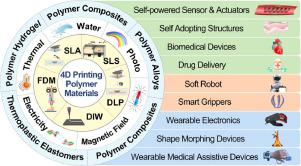Progress in Polymer Science ( IF 26.0 ) Pub Date : 2022-01-05 , DOI: 10.1016/j.progpolymsci.2022.101506 Peng Fu 1 , Haimei Li 1 , Jin Gong 2 , Zengjie Fan 3 , Andrew T. Smith 4, 5 , Kuangyu Shen 4, 5 , Tebyan O. Khalfalla 6 , Haofei Huang 3 , Xin Qian 5 , Jeffrey R. McCutcheon 4, 5 , Luyi Sun 4, 5

|
Since the concept of four-dimensional (4D) printing first emerged from additive manufacturing technologies in 2013, there has been growing interest from researchers worldwide to harness its benefits for advanced manufacturing and materials design. 4D printing has the potential to extend the processing of objects beyond complex geometries by giving dynamic properties to static printed structures, which can change over time. The shapes and/or properties of printed objects can change under various stimuli, including heat, light, pH, moisture, electricity, and magnetic field, and these changes can be pre-designed and well-controlled. 4D printing thus permits the creation of variable and controllable geometries by incorporating the time dimension. In recent years, the rapid technical developments in smart materials and new printing methods have greatly expanded the scope of 4D printing. This article reviews important 4D printing technologies in conjunction with the underlying polymer science and engineering. The challenges and future opportunities in 4D printing are also discussed.
中文翻译:

聚合物的 4D 打印:技术、材料和前景
自 2013 年四维 (4D) 打印概念首次出现在增材制造技术中以来,全球研究人员对利用其优势进行先进制造和材料设计的兴趣与日俱增。4D 打印通过为静态打印结构赋予动态属性(可随时间而变化),有可能将对象的处理扩展到复杂的几何形状之外。打印对象的形状和/或属性可以在各种刺激下发生变化,包括热、光、pH、水分、电和磁场,这些变化可以预先设计并得到很好的控制。因此,4D 打印允许通过结合时间维度来创建可变和可控的几何形状。最近几年,智能材料和新打印方法的快速技术发展极大地扩展了 4D 打印的范围。本文结合基础聚合物科学和工程回顾了重要的 4D 打印技术。还讨论了 4D 打印的挑战和未来机遇。











































 京公网安备 11010802027423号
京公网安备 11010802027423号